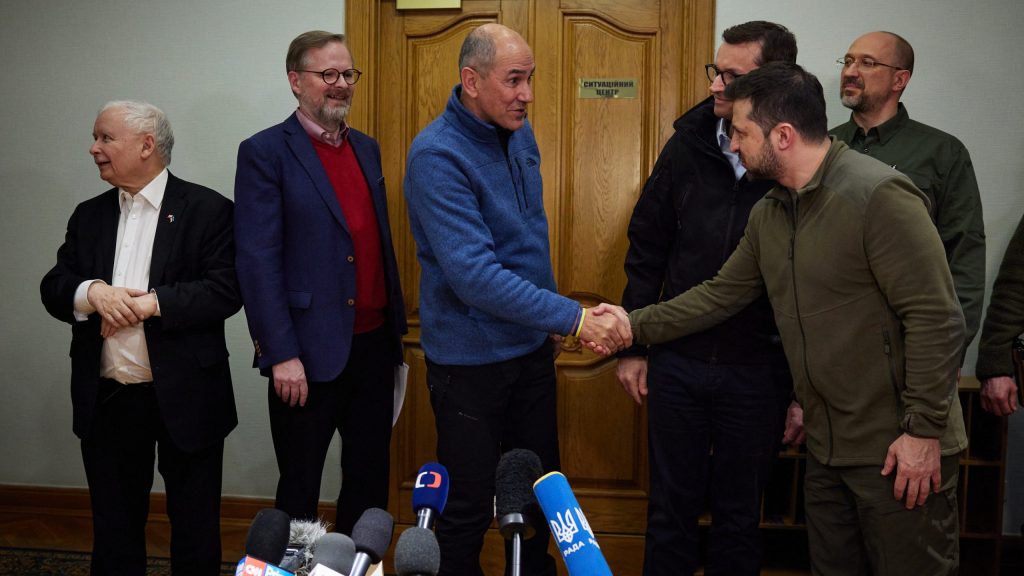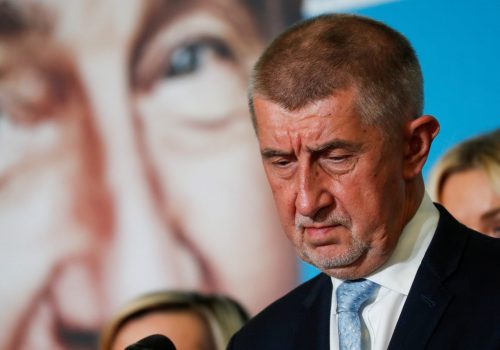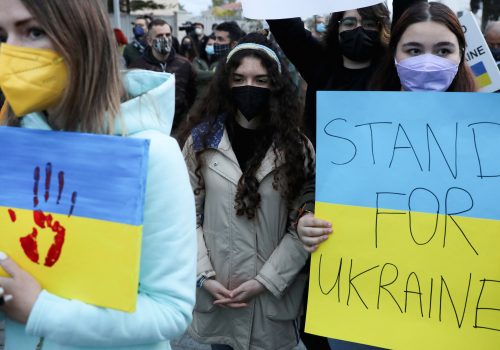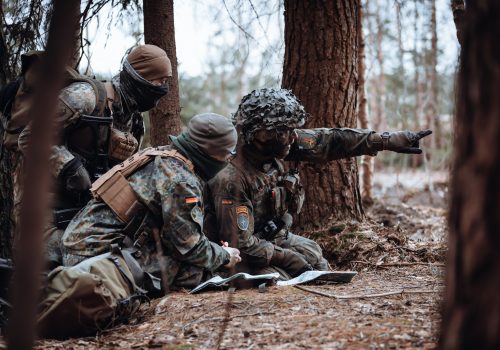As the West scrambles to maintain its united front against Russia’s invasion of Ukraine, the European Union (EU) member states of Central and Eastern Europe have led the way as some of the continent’s loudest moral voices, sending arms and humanitarian aid to Ukraine while receiving streams of refugees.
But while neighboring Poland has perhaps been most visible—hosting both US President Joe Biden and Vice President Kamala Harris in recent weeks while absorbing more than two million refugees—geography isn’t the only factor that determines who is a frontline state.
Take the Czech Republic, for example: Though nestled in the heart of Europe and away from the EU’s eastern border, its new government—together with the three Baltic countries, Poland, and the United Kingdom—spearheaded weapons delivery for Ukrainians when most EU member states were still hesitating. It is also now home to around 200,000 Ukrainian refugees.
So when Prime Minister Petr Fiala—along with his Polish and Slovenian counterparts, Mateusz Morawiecki and Janez Janša, respectively—traveled to Kyiv earlier this month to visit Ukrainian President Volodymyr Zelenskyy, it wasn’t just a powerful symbolic gesture. It was also a reflection of the region’s growing clout as a bridge between Brussels and Kyiv.
I spoke to Tomáš Pojar, Fiala’s chief foreign-affairs adviser, who accompanied the delegation to Kyiv. Below are six major takeaways I distilled from our conversation—which can be also read as a guideline for Europe’s next steps for engagement toward Ukraine.
- Europe’s most important task is to continue providing Ukraine with military support, especially anti-tank and -aircraft weapons. Quantity and time matter here, and the coming weeks are likely to be decisive in the war. Ukrainians are committed, but can’t defeat the Russian military without Western support. Moscow needs to understand that Europe stands firmly behind Ukraine, ready to provide what is needed to wreck Russian President Vladimir Putin’s plans. If Ukraine is properly equipped with more anti-aircraft weaponry, it can even create something akin to its own version of a no-fly zone (without, of course, achieving NATO-aided air superiority). Indeed, something similar is already happening in parts of the country’s airspace, where Russian planes and helicopters dare not enter. Military support is critical to any prospects for meaningful negotiation; if Putin sees the West hesitating, he is likely to press his advantage on the battlefield for quite some time.
- Europe must also continue pushing for stronger sanctions against the Kremlin, as efforts thus far seem to be quite effective. There are many options still available to the EU—not least in the field of energy—but as some member states call for restraint, the immediate task is to close loopholes, such as those facilitating sanctions evasion through third-party entities. And if needed, a sixth or even seventh sanctions package should be on the table. The key is to remember that continuing to do business with Russia enables the Kremlin to finance its war, thus creating a further burden that Europe will need to carry in the future—from accepting more refugees to paying for the stabilization and reconstruction of a devastated Ukraine.
- Ukraine needs a plan to rebuild. Beyond the immediate humanitarian needs of the Ukrainian people, Europe must already start thinking about postwar reconstruction. Even if we still don’t have a clear picture of the final scale of the wreckage (or even the final geographic extent of the country), an aid package on the scale of the Marshall Plan will likely be needed. At their summit in Brussels, European leaders discussed an EU recovery fund for Ukraine similar to one set up in 2020 amid the pandemic. The EU should organize a donor conference with NATO and partners from the Organization for Economic Cooperation and Development. France, as the head of the European Council through the end of June, should start laying the groundwork now, to be continued by the Czech Republic when it takes over the rotating presidency later this year. The success of the reconstruction could, in turn, showcase the value of liberal democracy—especially if a new Iron Curtain falls across Europe.
- Kyiv must attain a meaningful framework for cooperation with the West, even though Ukraine’s entry into NATO seems unlikely. By now, it’s clear that Ukraine deserves EU candidacy; yet accession is a long process with many political and administrative hoops to jump through. While Ukrainians must understand that there are no shortcuts, Kyiv should still get something soon. That’s why the European Union needs to invent a fast-track special partnership for Ukraine as part of the bloc’s overall reinvention for the post-post-Cold War period. But this new format needs to be credible: The effects of a protracted EU accession process are already on display in the Western Balkans, where countries have started searching for alternative patrons while backsliding on their reforms.
- Europe should offer asylum and humanitarian protection to Russian soldiers ready to surrender. Today, those who don’t want to fight their Ukrainian neighbors face three awful options: death, captivity in Ukraine, or a harsh prison sentence in Russia. Europe needs to offer an alternative, something similar to temporary humanitarian asylum. Such proposals would be more appealing to young soldiers than to officers, and even in the best-case scenario, the number who would avail themselves of the opportunity won’t be in the thousands. But even hundreds matter: It represents a powerful humanitarian gesture—a hand extended to a demoralized Russian military.
- The positive impact of the three prime ministers’ trip to Kyiv underscores the importance of having a diplomatic presence on the ground. Any EU member states that withdrew their diplomatic corps from Ukraine should consider sending them back to Kyiv. This is not just a gesture of solidarity: I was stationed in war-torn Syria when Damascus was shelled daily between 2013-2015, and while diplomatic work was difficult, it was still possible—and very much worthwhile. The picture we got on the ground was different and far more nuanced from the mediated images the rest of the world was getting. In Syria, the West left for good political reasons; in Ukraine, it should return as soon as possible.
Is the East the new West?
As Ivan Kravstev and Stephen Holmes noted in their 2019 book The Light that Failed, Eastern Europe had been mostly imitating the West since 1989. In the post-Cold War period, the chief aim in the East was to become—politically, economically, and socially—the new West. It was a mostly one-way stream of influence.
But now that’s partly changing. The countries of Central and Eastern Europe are becoming more relevant and inspiring, as their once-hardline stance on Russia is becoming increasingly mainstream.
Consider—in parallel to the Czech takeaways from Kyiv—Morawiecki’s recently published ten-point plan to “save” Ukraine. He focuses mainly on restrictive measures against Russia and proposes concrete steps that can be implemented almost immediately. They include, among other options, cutting off all Russian banks from SWIFT, blocking Russian ships from EU ports, suspending visas for all Russians, and a total ban on the export of technologies that can be used for war.
His suggestions emerged from the three prime ministers’ talks with Zelenskyy in Kyiv and were discussed with the Czechs and Slovenians (who did not sign under Morawiecki’s plan but support it). While many of the measures are not yet acceptable for certain EU member states, mainly because of the negative impacts on their own economies and interests, the discussion is now possible. Indeed, some of these points were already considered during last week’s European Council meeting in Brussels.
This wouldn’t have been feasible even a few months ago—when such proposals would have been deemed too radical.
Zelenskyy’s bravery and commitment is reshaping European politics and providing an opportunity for the EU’s eastern members to prove their political and diplomatic mettle. And they are seizing it: By traveling to a war zone, they indicated that European policy should be reinvented through one key word: courage. They’ve proven to their European counterparts that European politicians can—and must—be present in Ukraine right now.
And when it comes to ways forward in this crisis, their ideas will matter more than ever before.
“Europe must understand that if it loses Ukraine, it will never be the same again,” Morawiecki wrote on Twitter after his visit to Kyiv. “It will no longer be Europe. Rather it will be a defeated, humiliated, and pathetic version of its former self.”
Petr Tůma is a visiting fellow at the Atlantic Council’s Europe Center and a Czech career diplomat with expertise on Europe, the Middle East, and transatlantic relations.
Further reading
Thu, Oct 14, 2021
Is liberalism ending its losing streak in Central Europe?
New Atlanticist By Petr Tůma
The Czech opposition's victory could inspire other democratic forces across the region.
Tue, Mar 1, 2022
New crowdsourcing campaign can help save Ukraine
UkraineAlert By Petr Tůma
A new crowdsourcing initiative aims to make the most of the Czech Republic's extensive stocks of Soviet-era weapons in order to bolster Ukraine's ability to defend itself against Vladimir Putin's Russian invasion.
Tue, Mar 29, 2022
What the Baltic presidents want the West to do now against Russia
Event Recap By
Estonian President Alar Karis, Latvian President Egils Levits, and Lithuanian President Gitanas Nausėda, proposed a number of options to counter Russian aggression at an Atlantic Council Front Page event Tuesday.
Image: Ukrainian President Volodymyr Zelenskyy greets Slovenian Prime Minister Janez Jansa in Kyiv, Ukraine, on March 15, 2022. The prime ministers of Poland, Czech Republic, and Slovenia were in Kyiv to speak with Zelensky and Prime Minister Denis Shmyhal with the approval from the EU. Photo by Ukrainian Presidential Service via ABACAPRESS.COM/REUTERS



